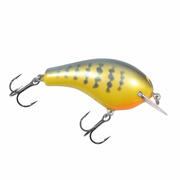Largemouth Bass: Techniques - Crankbaits
Table of Contents
- Bass Fishing with Crankbaits
- Overview: Why Crankbaits Work
- How to Fish Crankbaits
- Retrieve Techniques
- Selecting Crankbaits
- Colors, Sizes, and Brands
- Recommended Gear
- How Different Lines Affect Crankbait Depth
- Example Chart: Line Diameter vs. Crankbait Depth
- YouTube Resource
- Other Popular YouTube Search Terms for Crankbaits
- Community & Expert Tips
Bass Fishing with Crankbaits

Image Credit: BagleyBait
Crankbaits are one of the most popular lures in bass fishing due to their flashy, erratic action and ability to mimic injured baitfish. In this extensive guide, we’ll explore why crankbaits work, how to fish them, how to select the right colors and sizes, gear recommendations, the effects of different line types and diameters on lure depth, and expert tips from seasoned bass anglers.
Overview: Why Crankbaits Work
Crankbaits are hard-bodied lures equipped with a lip that causes them to dive and wobble when retrieved. Their effectiveness comes from:
- Diving Action: The lip design makes the lure dive to a preset depth, then wobble in a lifelike manner.
- Flash and Vibration: Bright colors and reflective surfaces, combined with a vibrating action, create both visual and tactile stimuli that trigger bass strikes.
- Versatility: With options for shallow, medium, and deep-diving models, crankbaits can be fished in a variety of water conditions and depths.
How to Fish Crankbaits
Retrieve Techniques
Experiment with various retrieves to determine what triggers strikes:
- Steady Retrieve: Maintain a consistent pace to allow the bait to dive and wobble uniformly.
- Stop-and-Go Retrieve: Retrieve at a moderate pace, then pause; the sudden stop mimics a dying baitfish.
- Jerk-and-Pause: Give short, sharp jerks with your rod tip followed by brief pauses. This erratic action can provoke reaction strikes.
- Variable Speed: Alternate between fast and slow retrieves to find the rhythm that bass respond to in your fishing spot.
Selecting Crankbaits
Colors, Sizes, and Brands
Your choice of crankbait should reflect local forage and water conditions:
- Colors:
- Natural Colors: Greens, browns, and silvers work well in clear water by imitating local baitfish.
- Bright/Fluorescent: Chartreuse, orange, and white are effective in stained or low-light water.
- Sizes:
- Smaller Models (1½" – 2½"): Great for finesse presentations when bass are pressured.
- Larger Models (3" – 4"): Better for covering more water and attracting aggressive bass.
- Popular Brands:
- Rapala, Strike King, Bomber, Megabass, and Blue Fox are favorites in the bass fishing community.
Recommended Gear
| Gear Component | Recommendation |
|---|---|
| Rod | A medium to medium-heavy rod (6'6" to 7') with fast action for sensitive hooksets and long casts. |
| Reel | A reliable spinning or baitcasting reel with a smooth drag system to handle sudden, aggressive strikes. |
| Line | Braided or fluorocarbon line in the 10-20 lb test range; fluorocarbon is ideal in clear water for its low visibility. |
How Different Lines Affect Crankbait Depth
The type and diameter of your fishing line can influence how deep your crankbait runs:
- Thinner Lines (e.g., 6–8 lb test monofilament):
- Advantages: Minimal drag and stretch, allowing the bait to dive deeper with a more natural fall.
- Example: A shallow-diving crankbait might reach 3.5–4 feet with a thin monofilament.
- Thicker/Braided Lines (e.g., 20 lb test braid):
- Advantages: Higher abrasion resistance, essential for fishing in heavy cover.
- Drawbacks: Increased diameter creates more drag, often causing the bait to run shallower.
- Example: The same bait might only reach 2–2.5 feet when retrieved on a thick braided line.
Example Chart: Line Diameter vs. Crankbait Depth
| Line Type & Test | Estimated Diameter | Expected Dive Depth (Shallow Crankbait) |
|---|---|---|
| 6 lb Monofilament | ~0.008" | 3.5 – 4 feet |
| 10 lb Fluorocarbon | ~0.010" | 3 – 3.5 feet |
| 20 lb Braided | ~0.012" | 2 – 2.5 feet |
Note: Actual depths vary with bait design, water conditions, and retrieve speed.
YouTube Resource
For a visual demonstration and expert advice on using crankbaits, click the image below to search for "Fishing Crankbaits tips" on YouTube. This thumbnail is taken from the first video result:
Other Popular YouTube Search Terms for Crankbaits
Below is a table with additional popular search terms related to crankbait fishing. Click the links to explore more videos (each uses a standard thumbnail icon):
| Search Term | Link |
|---|---|
| Crankbait Techniques | |
| Best Crankbaits for Bass | |
| Crankbait Retrieval Methods | |
| Crankbait Reviews & Tips |
Community & Expert Tips
- Adapt Your Retrieve: Experiment with various retrieves based on water conditions—steady, stop-and-go, or jerk-and-pause methods can all be effective.
- Match the Forage: Select crankbaits that mimic the color, size, and movement of the local baitfish.
- Line Matters: In clear water, opt for thinner fluorocarbon for deeper runs; in heavy cover, braided line provides durability.
- Gear Up: A fast-action rod is essential for quick hooksets when a bass strikes the moving lure.
- Local Knowledge: Engage with local fishing communities and online forums to learn which crankbaits work best in your area.
Ask AI for More Info
Try our AI assistant for free—sign up to access this powerful feature.
👉 Sign Up to Ask AI